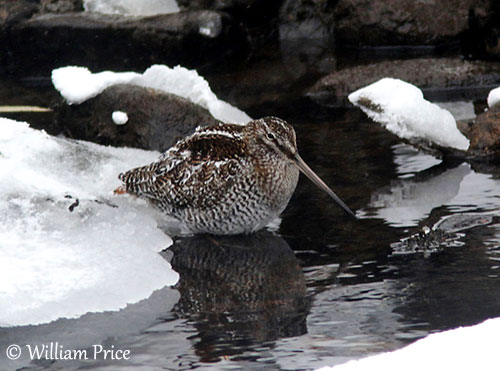
SUBSPECIES AND RANGE:
The Solitary Snipe has two subspecies.
G.s. solitaria (described above) occurs at high elevations in C Asia, in SC Siberia, Mongolia to NW China. It winters in Tien Shan and Pamir to Himalayas, S to Pakistan and N India, and E to Myanmar.
G.s. japonica (displayed) is found in SE Siberia and NE China and from Stanovoy to Kamchatka. It winters from Amurland and Sakhalin, S to Korea, Japan and E China.
This race may show more rufous and less white on the upperparts than nominate.
HABITAT:
The Solitary Snipe breeds in mountain bogs and river valleys above the treeline, between 2,400 and 5,000 metres of elevation. On migration and outside of breeding season, it frequents similar habitats, marshes and swamps at lower altitudes. It can be seen on shores of unfrozen rivers in foothills, near mountain streams and occasionally on coast.
CALLS AND SONGS: SOUNDS BY XENO-CANTO
The Solitary Snipe gives a deep, far-carrying “chok-a-chok-a” during the displays. We can also hear a mechanical drumming sound produced by vibrations of the stiff outer rectrices during the flight. When flushed, the bird utters a harsh “kensh”.
BEHAVIOUR IN THE WILD:
The Solitary Snipe feeds on invertebrates such as insects and their larvae, worms and small snails.
It forages alone by probing deeply in the mud with its long bill. It often bobs when feeding, an up-and-down rhythmical bouncing action, like the Jack Snipe.
When disturbed, is crouches and remains motionless among the vegetation, protected by the cryptic plumage. If flushed, it usually alights again into the marsh after a short flight.
The Solitary Snipe performs aerial displays typical of the genus Gallinago. The male flies high in circles prior to a strong dive during which the stiff outer rectrices produce a drumming sound.
It nests on the ground.
The Solitary Snipe is partial migrant and moves over short distances. The sedentary birds usually reach lower elevations after breeding, but others migrate towards other regions. The dispersal starts in late July.
The flight is fairly slow and heavy.
REPRODUCTION OF THIS SPECIES:
The breeding season occurs from late June to August.
The nest is a depression on the ground made with dry grass and lined with bits of dead rushes, grass or moss. It is usually well-hidden in the vegetation, in tufts of grass or sedges.
The female lays four eggs.
PROTECTION / THREATS / STATUS:
The Solitary Snipe has currently stable population roughly estimated to number 11,000/110,000 individuals (2006).
Any declines or substantial threats are known. The species is not globally threatened and evaluated as Least Concern.
Fr: Bécassine solitaire
Ang: Solitary Snipe
All: Einsiedlerbekassine
Esp: Agachadiza Solitaria
Ita: Beccaccino solitario
Nd: Bergsnip
Sd: bergbeckasin
Photographer:
William Price
PBase-tereksandpiper & Flickr William Price
Text by Nicole Bouglouan
Sources:
HANDBOOK OF THE BIRDS OF THE WORLD Vol 3 by Josep del Hoyo-Andrew Elliott-Jordi Sargatal - Lynx Edicions - ISBN: 8487334202
SHOREBIRDS by Peter Hayman, John Marchant and Tony Prater – Christopher Helm – 1986 – ISBN: 0747014035
GUIDE DES LIMICOLES de D. Taylor - Delachaux et Niestlé - ISBN : 2603014080
Waders of Europe, Asia and North America De Stephen Message, Don W. Taylor – Editeur: Bloomsbury Publishing, 2016 – ISBN: 1472946022, 9781472946027 – 224 pages
Birds.kz - Gallinago solitaria (Hodgson, 1831)
Wikipedia, the free encyclopaedia
Solitary Snipe
Gallinago solitaria
Charadriiformes Order – Scolopacidae Family
INTRODUCTION:
The Solitary Snipe is larger and stockier than other Gallinago species. It is usually found at high elevations. This species occurs in Asia, from NE Iran to Japan and Korea. Two subspecies share this wide range. They breed in habitats above the treeline, often near mountain streams.
It is a partial migrant and usually moves to lower elevations during periods of cold weather.
The Solitary Snipe is not globally threatened. The numbers appear to be low, but the population is currently suspected to be stable.
DESCRIPTION OF THE BIRD:
Biometrics:
Length: 29-31 cm
Wingspan: 51-56 cm
Weight: 126-227 g
The Solitary Snipe has brownish upperparts with narrow white and rufous fringes and bars, involving vermiculated appearance. On the upperwing, the tertials are usually heavily barred pale and dark brown. Some whitish lines can be seen between mantle and scapulars. The flight-feathers are dark brown with some narrow white tips, forming a pale trailing edge. Greater and primary coverts also have white tips, whereas median coverts have broad, brownish-white edges. The tail is fairly long and shows narrow white tips, but we can see a bright rufous subterminal band on central rectrices.
On the underparts, the breast is rufous-brown, especially on the sides, while the belly is white with brown barring on the flanks. On the underwing, coverts and axillaries are heavily barred dark brown and white.
The head is greyish-white with dark rufous-brown crown, lores, upper ear-coverts and line on lower cheeks. There is a narrow, short, whitish central stripe on the crown. The face is whitish.
The long bill has brownish base and blackish tip. The eyes are dark brown. Legs and feet are yellowish-green to yellowish-brown.
Male and female have similar appearance but the female is slightly larger.
The juvenile is very similar to adults.
